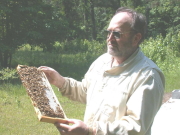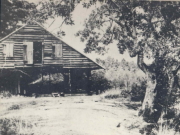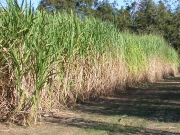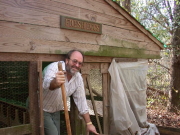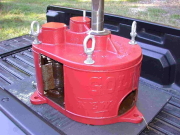|
In the end, our cane mills are about producing syrup.
Sugars are the principal ingredients by weight of syrup and confer protection
against spoilage, provide sweetness and body, and contribute to color if
caramelized. Therefore, sugars merit some mention on this site. First, a
general description of carbohydrates is given. Second, relevant carbohydrates
are described. Third, the conversion of selected carbohydrates is outlined.
Finally, why this matters to syrup makers is addressed.
Sugars are ubiquitous, diverse, and abundant in
plants, where they serve a myriad of functions. The simplest of sugars are
strings of 3 to 7 carbon atoms. Carbon forms 4 bonds, and the two bonds
remaining (after the formation of bonds with neighboring carbons) are used to
bond with a hydrogen atom on one "side" and a hydroxyl (OH) moiety on the
other. Simple sugars, therefore, are characterized as having the ratio of C:H:O
= 1:2:1; in short, sugars are carbohydrates. In the following narrative, I have
placed in bold the main carbohydrates that syrup makers are concerned with.
Glucose (= dextrose), fructose (=
levulose, fruit sugar), and sucrose (= table sugar, cane sugar, beet sugar) are
the main sugars in cane juice, and starch is the starting point for
making corn syrup (which is blended with cane syrup by some syrup
makers).
Glucose and fructose have six carbon atoms. Because
each of the carbon atoms along the string can have the H on the "left" or on
the "right" if a flat projection of the string is made, many different sugars
have six carbons, and, of course, the same goes for sugars of other
sizes.
Simple sugars can linked together to form larger
molecules, such as sucrose. Note that sucrose is made from one
glucose molecule (the six-membered ring on the left) joined to a fructose
molecule. This figure also makes it easy to visualize, as discussed above, how
so many different sugars can result simply by "flipping" the H and the OH.
Lactose (milk sugar) and maltose (discussed later) are other examples of
sugars that are formed from 2 units of 6-carbon sugars. You have probably
noticed that the trivial name of many sugars ends in -ose. Note that sucrose is made from one
glucose molecule (the six-membered ring on the left) joined to a fructose
molecule. This figure also makes it easy to visualize, as discussed above, how
so many different sugars can result simply by "flipping" the H and the OH.
Lactose (milk sugar) and maltose (discussed later) are other examples of
sugars that are formed from 2 units of 6-carbon sugars. You have probably
noticed that the trivial name of many sugars ends in -ose.
Finally, very large carbohydrates can be made by
linking up to tens of thousands of simple sugars to form long chains.
Cellulose-cotton fiber is almost pure cellulose-is an extremely abundant
resource and is used to make a variety of products such as paper and plastics.
Cellulose is a chain of glucose molecules joined from the # 1 carbon on one to
the # 4 carbon on the next. Starch is another large carbohydrate made
exclusively from glucose. Starch consists of two kinds of chains, though. One
kind of chain (amylose) is linear (again, the # 1 and # 4 are linked to form
the chain). The other kind of chain (amylopectin) has a 1>4 backbone,
but also has branches; amylopectin is very similar to glycogen, which is the
main readily available food reserve stored in animals ranging from oysters to
humans.
Two important points arise. The physical and
biological properties of apparently very similar carbohydrates are vastly
different. Take cellulose and amylose from the preceding paragraph. Both are
simply chains of glucose units connected between the #1 and # 4 carbons.
However, the orientation of the connecting bond is different. Cellulose is very
strong with a tensile strength exceeding steel; starch has no strength. Starch
forms a gel in hot water, as when we make gravy; cellulose is unphased by
water, as we observe each time we wash cotton clothes. Starch from wheat, rice,
and corn are the foundation of a good diet; we cannot digest
cellulose.
Sucrose and starch can be broken down using simple
chemical means. Sucrose is broken down into glucose and fructose by heating
with acid. Starch is also broken down into fragments by acid treatment;
depending on the duration, the strength of the acid and the temperature,
breakdown can be complete, all the way to individual glucose units. Less
complete breakdown of starch yields, among other products of various lengths,
maltose (a fragment of two glucose units). Some types of corn syrup are
prepared by partial or complete acid hydrolysis of corn starch. There are many
different corn syrup formulations. I chromatographed one source of corn syrup
used by many syrup makers in South Georgia, and it was pure glucose. One the
other hand, I chromatographed a sample of syrup blend produced in South Georgia
from a different brand of corn syrup and it could not have been pure
glucose.
Carbohydrates can be converted from one to another
using enzymes (proteins that specifically speed certain reactions.) A commonly
used enzyme is an invertase obtained from yeast. This enzyme catalyzes the
breakdown of sucrose into glucose and fructose. (Glucose and fructose are thus
invert sugars because a physical property, rotation of plane-polarized light,
has been inverted [changed from plus to minus] by the conversion of sucrose to
the two 6-carbon sugars). If the treatment is too short or if the conditions
(e.g., amount of invertase) are not optimum, all the sucrose may not be broken
down. A second commonly used enzyme is one of the amylases, which partially
break down starch. Amylases are used to manufacture some corn syrups and to
prevent gelling of sorghum syrup. Finally, another enzyme, an isomerase,
converts a portion of glucose to fructose. Use of this enzyme permits the
production of High-Fructose Corn Syrup (after the starch has been converted to
glucose). Corn syrup is, of course, a cheap sweetner and various formulations
find their way into many foods such as breakfast cereals, canned fruit,
ketchup, soft drinks . . . . As you have noticed, the trivial names of enzymes
end in -ase.
What does all this mean to a syrup maker?
- Sugaring. Of the
three sugars in cane juice, sucrose is the least soluble (i.e., syrup will
"hold" less sucrose before it forms crystals). Although some sugaring is
acceptable, it has two drawbacks (esthetics to some consumers and potential
spoilage of the remainder of the syrup). Fortunately for the syrup maker,
some sucrose is chemically degraded to glucose and fructose by heating
because the juice is slightly acidic (pH ~ 5.2) [see section above]. (An
early extension bulletin indicated that the longer heating time in kettles is
an advantage because the syrup contains less sucrose, if all else is equal.)
There are three remedies for sugaring under the control of the syrup maker.
First, he or she can choose a variety of
cane that is less likely to form sugar in syrup. This is a very effective
strategy to produce excellent excellent
syrup. Second, he or she can add corn syrup to the sugar-cane syrup,
effectively diluting the sucrose. Many syrup makers opt for this choice.
Whether to blend or not to blend is a matter of personal preference, of
course, and some prefer the milder taste of the blend anyhow. Third, and
finally, the sucrose content of the syrup can be diminished by the use of
invertase (see Walton CF, EK Ventre 1935 How to prevent sugaring of sugarcane
sirup. USDA Circular). Walton and Ventre suggested taking the juice to
semi-syrup (20 º Baumé) before treatment. As I understand it,
invertase is considered a "processing aid," not an ingredient, and therefore
does not need to be listed on the label.
Fructose is the most soluble of the three sugars and is often chosen in food
manufacture for that reason (e.g., to prevent "sandiness" in ice
cream).
Interestingly, honey bees are faced with the same problem as syrup makers.
Nectar, like cane juice, is mostly sucrose, glucose, and fructose. Honey bees
inject invertase into the nectar as it is converted to honey. Thus, honey is
mainly glucose and fructose. Even so, some nectars, like that produced by the
mustard family, contain so much glucose that the honey crystallizes quickly.
On the other hand, tupelo nectar has so much fructose that honey produced
from it never crystallizes.
-
Spoilage. Of course, the first line of
defense against spoilage is sterilization. A second potential line is the
addition of a "preservative" such as benzoate. Again, this is a matter of
personal preference, but note that we accept benzoate in products such as
soft drinks. However, the sugar composition may also play a role. A primary
historical means of preventing the growth of spoilage organisms is to deny
the organisms adequate water. This goal is accomplished directly by drying
the product such as fruit slices or by "drawing" the water out with usually
salt. The relevant comparative physical-chemical parameter to measure
concentration in this context is osmolality (osm; not osmolarity), which in
this case is the ratio of sugar molecules to water molecules. What all this
means theoretically is that for a syrup of given sugar content (weight of
sugar per volume of syrup), a sucrose syrup would be the easiest for the
spoilage organism to thrive in.
Another property of a solution that depends on osmolality is elevation of
boiling point. For a typical cane syrup, this value is about 12-13 º F
above the boiling point of water, or about 225 º F along the coastal
areas. As indicated in the discussion above, this value will depend on
which sugar (and other components plus deviations from ideality) in the
syrup predominates. (If sucrose predominates, a lower boiling point would
be expected, and if the 6-C sugars predominate, a higher boiling point
would be expected.) As a general rule, thermometers, which provide a
continuous reading, are used in evaporators whereas hydrometers are used in
kettles, as discussed below.
-
Thickness. The viscosity, or resistance to
flow, comes into play in two different ways. First, some syrup makers rely
on viscosity (i.e., flaking off a dipper) to determine when the syrup is
finished. Second, some people have a preference for thicker or thinner
syrups. The least viscose sugar is fructose, with glucose being slightly
more viscose. Sucrose is, by far, the most viscose (the relative viscosity
at room temperature is almost twice as high for sucrose). Ironically, a
syrup made of sucrose will be thicker than a syrup made of fructose (or
glucose) even when the latter contains more sugar by weight! These facts,
along with the sharp temperature dependence of viscosity, explain the
difficulty of judging when the syrup is done by using "flaking." On the
other hand, the densities of solutions made from different sugars at the
same concentration (weight per volume) vary by less than 1 %, attesting to
the utility of a hydrometer. Density, like viscosity, is affected by
temperature, however. For example, a desirable density for finished cane
syrup is 38.5 to 39 º Baumé at 70º F. This same syrup would
test at 34.5 º Baumé at 210 ºF. (Thanks to McCalip and
Walton for these figures from an article in USDA Bulletin 1370,
1925).
-
Sweetness. Fructose is the sweetest.
|

